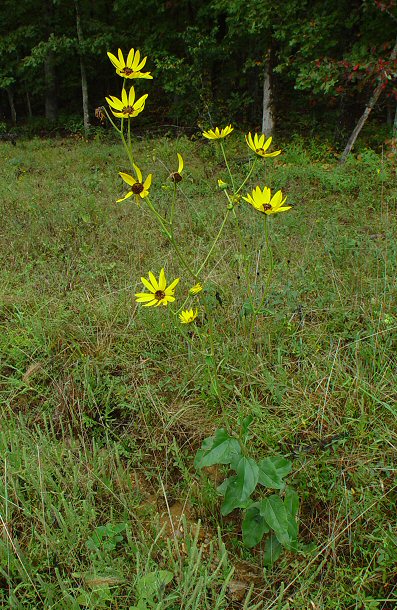Helianthus silphioides Nutt.
Rosinweed Sunflower

Native
CC = 7
CW = 5
MOC = 13
© DETenaglia
Helianthus silphioides Nutt.Rosinweed Sunflower | |
 |
Native CC = 7 CW = 5 MOC = 13 |
© DETenaglia |
|
Family - Asteraceae/Heliantheae Habit - Perennial forb, sometimes with very short, thick rhizomes, often occurring as clumps. Stems - Ascending to erect, to 2.5 m, single or multiple, sparsely to densely pubescent with short, ascending, slender hairs and/ or more or less spreading, short, stiff, pustular-based hairs toward the base, usually glabrous above the midpoint.
Leaves - Opposite, simple, petiolate, at 8-15 nodes along stem. Petioles 1-4 cm long, not winged. Blades 3-15 cm long, 1-15 cm wide, ovate to broadly ovate or nearly circular, mostly 1.0-1.7 times as long as wide, the uppermost leaves occasionally somewhat narrower, rounded or abruptly short-tapered at the base, rounded or broadly angled to a bluntly pointed tip, the margins flat and finely toothed or scalloped to nearly entire, the surfaces strongly roughened with moderate, minute, stout, pustular-based hairs, but lacking sessile glands, with 3 main veins, the lateral pair branching from the midnerve at or just above the base of the blade, arching upward.
Inflorescence - Open clusters or panicles of flowering heads, sometimes reduced to a solitary terminal head. Heads - Radiate. Involucre 8-15 mm long, 10-20 mm in diameter, slightly shorter than to about as long as the tips of the disc corollas, the bracts in 3 or 4 noticeably unequal, overlapping series, oblong to oblong-ovate, rounded or narrowed to a bluntly pointed, tightly appressed tip, the margins often with a fringe of minute, spreading hairs, the outer surface glabrous or sparsely hairy toward the base. Receptacle convex, the chaffy bracts 8-10 mm long, narrowly oblong to narrowly oblong-oblanceolate, angled or short-tapered to a sharply pointed, green, straw-colored, or purplish-tinged, glabrous tip, occasionally with a pair of additional short, broad lobes toward the tip, the outer surface also usually glabrous.
Flowers - Ray florets 12-15, sterile, the corolla 1.5-2.0 cm long, glabrous or the outer surface with inconspicuous, short, slender hairs along the veins. Disc florets perfect, the corollas 6-7 mm long, reddish brown to dark purple at the tips, the lobes and tip of the tube often minutely hairy on the outer surface. Pappus of 2 scales 2.5-3.0 mm long, these lanceolate to narrowly triangular, sometimes with an irregular pair of small basal lobes, tapered to a sharply pointed, often minutely awnlike tip.
Fruits - Achenes 3.0-4.5 mm long, narrowly wedge-shaped to narrowly obovate, flattened but sometimes more or less 4-angled in cross-section, the tip and margins moderately to densely pubescent with short, ascending hairs, the surface otherwise glabrous, uniformly dark brown or more commonly with fine, darker and lighter brown mottling.
Flowering - August - October. Habitat - Streambanks, sand prairies, upland forest openings, fields, fencerows, roadsides. Typically on acid soils. Origin - Native to the U.S. Lookalikes - Other species of Helianthus and Silphium. Other info. - This showy species can be found in the extreme south of Missouri, particularly toward the southeastern corner. It is a relatively uncommon species, with a total range restricted to a few states in the lower U.S. Midwest and Gulf Coast states. The plant is recognized by its showy yellow-rayed heads with brown centers, rounded involucral bracts, and broad leaves with very rough surfaces. The leaves are usually predominantly opposite, although plants will often produce a number of alternate nodes as well, so this character must be interpreted with caution. The plant is attractive, and according to Steyermark, does well in cultivation. Photographs taken off Hwy C., Carter County, MO., 8-31-03 (DETenaglia); also in Stoddard County, MO, 9-7-2019; and near Harrison, AR, 9-6-2024 (SRTurner). |